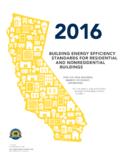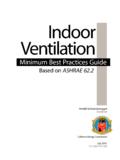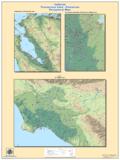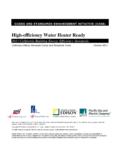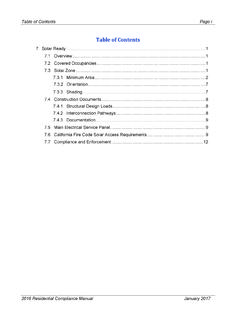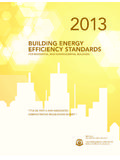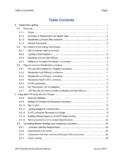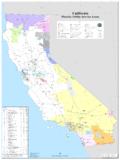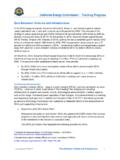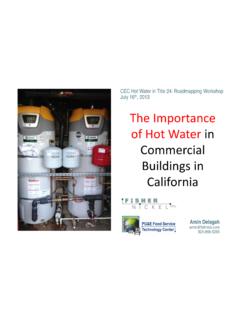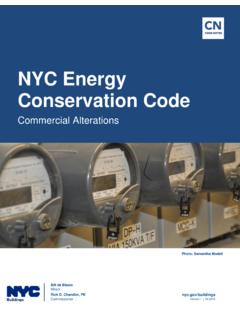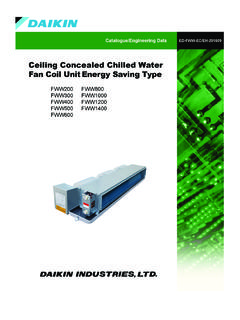Transcription of Table of Contents - California Energy Commission
1 Table of Contents Page i Table of Contents 5 Water Heating Requirements .. 1 Overview .. 1 What s New for 2016 .. 1 At a Glance .. 3 Water Heating Energy .. 3 Residential Water Heating Equipment .. 4 Instantaneous Water Heaters .. 4 Storage Water Heater .. 5 Water Heater Maintenance .. 7 Mandatory Requirements for Water Heating .. 9 Equipment Certification .. 9 Equipment Efficiency .. 9 Isolation Valves .. 11 High Efficiency Water Heater Ready .. 11 Mandatory Requirements for Hot Water Distribution Systems .. 13 Prescriptive Requirements for Water Heating .. 18 Single Dwelling Units .. 18 Multiple Dwelling Units: Multi-family, Motel/Hotels and High-Rise 22 Performance Approach Compliance for Water Heating .. 26 Energy Budget Calculation .. 26 Systems Serving Single Dwelling Unit.
2 26 Systems Serving Multiple Dwelling Units .. 27 Treatment of Water Heater Efficiency .. 28 Compliance Issues .. 28 Distribution Systems .. 28 Types of Water Heating Distribution Systems .. 28 Systems Serving Single Dwelling Unit .. 29 Systems Serving Multiple Dwelling Units .. 35 Combined Hydronic System .. 36 Combined Hydronic .. 36 Shower Heads .. 36 Certification of Showerheads and Faucets .. 36 2016 Residential Compliance Manual January 2017 Page ii Table of Contents Solar Water Heating .. 36 Solar or Recovered Energy in State Buildings .. 37 Prescriptive Requirements for Solar Water Heating .. 38 Performance Approach Compliance for Solar Water Heating .. 39 Swimming Pool and Spa Heating .. 39 Swimming Pool and Spa Types .. 39 Mandatory Requirements for Pools and Spas .. 39 Compliance and Enforcement.
3 43 Design Review .. 43 Field Inspection .. 44 HERS Field Verification and/or Diagnostic Testing .. 44 Glossary/Reference .. 45 General Glossary/Reference for Water Heating .. 45 General Glossary/Reference for Swimming Pool and Spa .. 45 2016 Residential Compliance Manual January 2017 Water Heating Requirements Overview Page 5-1 5. Water Heating Requirements Overview 5 describes the compliance requirements for domestic water heating for residential dwellings, including single-family, and low-rise (three or fewer habitable floors) multifamily buildings with a dedicated water heater for each dwelling unit or a central system that serves multiple dwellings. This chapter also describes common water heater types, best practices for water heater maintenance, hot water distribution system designs, and examples of commonly asked questions regarding compliance with Energy Standards requirements.
4 F or general information about compliance and enforcement please see Chapter 2 of this compliance manual. What s New for 2016 This section summarizes changes to the requirements for residential water heating for the 2016 Energy Standards. Please see Sections and for detailed information on the mandatory and prescriptive water heating requirements in the 2016 Energy Standards. Mandatory Requirements valves must be installed on instantaneous water heaters that have an input ratinggreater than kBTU per hour (2 kilowatts [kW]). The valves must be installed on thecold water line leading to the water heater and the hot water line leaving the water discussed in Section of this chapter, manufacturers recommend flushing the heatexchanger in instantaneous water heaters. Isolation valves simplify this routinemaintenance practice, which reduces the cost and burden of maintaining the water water heaters do not need to have blankets anymore.
5 The 2013 EnergyStandards required storage water heaters with efficiency levels equivalent to the minimumfederal efficiency standard to be externally wrapped (such as with a water heater blanket)with insulation of R-12 or greater. This requirement has been deleted. With the amendedfederal standards that went effect on April 16, 2015, external insulation of water heaterstorage tanks is no longer alterations, all newly installed hot water piping and existing accessible piping must beinsulated if installing new piping at the time an existing water heater is replaced (that is,replacement water heating systems). Prescriptive Requirements The prescriptive requirements for new construction and additions for single-family buildings and multifamily buildings with a dedicated water heater for each dwelling unit have been updated.
6 A dwelling unit is defined as a residence with a dedicated water heater. Use of the term pertains to both a single-family home and a unit (such as an apartment) within a multifamily building that has a dedicated water heater. The 2016 prescriptive requirements for single-family buildings and multifamily buildings with a dedicated water heater in each dwelling unit are as follows: Option 1: Install a natural gas or propane instantaneous water heater that meets the minimum requirements in California s Title 20 Appliance Efficiency Regulations, Section (f) for federally regulated appliances. 2016 Residential Compliance Manual January 2017 Page 5-2 Water Heating Requirements Overview Option 2: Install a natural gas or propane storage water heater with a rated storage volume of 55 gallons or less that meets the minimum requirements in California s Title 20 Appliance Efficiency Regulations, Section (f) for federally regulated appliances.
7 In addition, the building must comply with the HERS-verified Quality Insulation Installation (QII) requirements (see Chapter 3 of this compliance manual), as well as one of the following requirements: 1. HERS-verified pipe insulation (see Reference Appendix1 RA , , , and for the requirements of proper installation of pipe insulation and Section of this chapter) 2. HERS-verified compact hot water distribution design (see Reference Appendix RA and for requirements and Section of this chapter) Option 3: Install a natural gas or propane storage water heater with a rated storage volume more than 55 gallons and an input rating of 105,000 BTU/hr or less. The water heater must meet the requirements in California s Title 20 Appliance Efficiency Regulations Section (f) for federally regulated appliances. In addition, the building must comply with one of the following: 1.
8 HERS-verified pipe insulation 2. HERS-verified compact hot water distribution design. There is no longer a prescriptive option that allows electric water heating. Users that wish to use electric water heating can comply with the Energy Standards using the performance approach. Performance Compliance Options 1. The water heating Energy budget is now based on the Energy performance of a natural gas instantaneous water heater that meets the minimum requirements in California s Title 20 Appliance Efficiency Regulations Section (f) for federally regulated appliances. 2. The point-of-use distribution credit no longer requires HERS verification. 1 The Reference Appendices can be downloaded on the California Energy Commission website for the 2016 Energy Standards. 2016 Residential Compliance Manual January 2017 Water Heating Requirements Overview Page 5-3 At a Glance Table 5-1 provides an overview of the location of the water heating requirements in the 2016 Energy Standards by construction and building type.
9 Table 5-1: Overview of Water Heating Requirements in the Energy Standards and this Chapter Type Mandatory Requirements Prescriptive Requirements Performance Requirements Standards Section Manual Section Standards Section Manual Section Standards Section Manual Section Single-family home Newly built ; (n) (c)8A i,ii,iii (b) Single-family home Addition ; (n) (a)1D (a)2 Single-family home Alteration ; (n) (b)1 (b)2 Multi-family Newly built individual dwelling units ; (n) (c)8B (b) Water Heating Energy Water heating accounts for the largest share of natural gas usage (49 percent) in California homes. Nearly 90 percent of California homes have natural gas water heating, with the common water heater type being a 40- or 50-gallon atmospheric combustion storage water heater.
10 Standby loss associated with the center flue design represents about 25-35 percent of the annual Energy use of a typical gas storage water heater system. Roughly 6 percent of households use electricity to heat water, and most of the remaining homes use propane (liquefied petroleum gas or LPG). Total Energy use associated with water heating consists of the end use, heater inefficiencies, standby loss, and distribution system inefficiencies. Figure 5-1 below shows the Energy flows that constitute water heating Energy usage. Hot water draws at the end use points (for example, faucets, showers, and so forth) represent the useful Energy consumed. In most cases, hot water that is actually used represents the largest fraction of water heating Energy use, although in situations when there are very few hot water draws, standby losses from the water heater and the hot water distribution system can exceed the quantity of useful Energy consumed at the end point.
